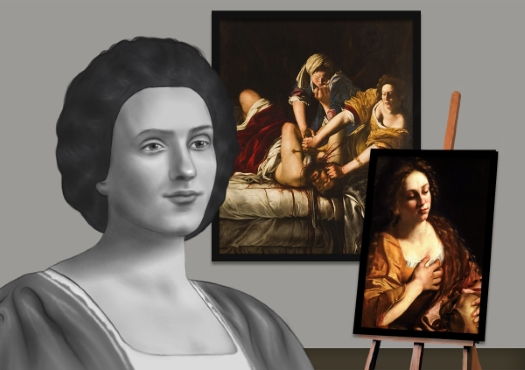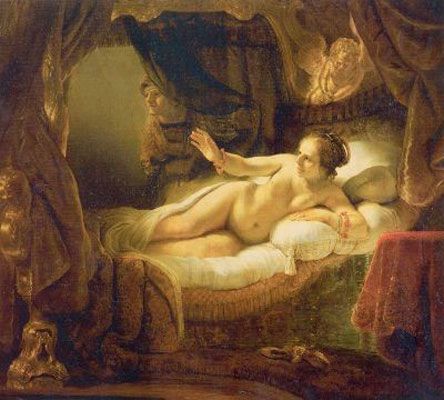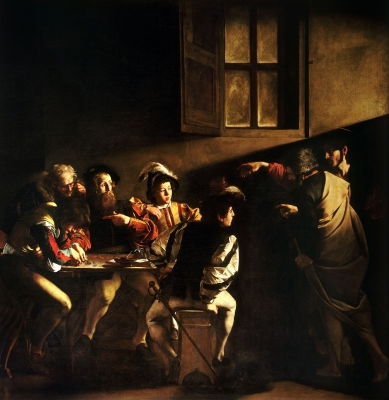Summary of Artemisia Gentileschi
Centuries ahead of her time, Artemisia Gentileschi was one of the first and only female artists to achieve success in the seventeenth century. Following in the footsteps of Caravaggio, her Baroque paintings were some of the most dramatic and dynamic of her generation and she became known for her realism, her accomplished use of chiaroscuro, and for placing women and their stories at the center of all her images. Her surviving works present a unique personal perspective on the cultural and social norms of the period, norms which she often intentionally inverted, using her position as an artist to comment on the male-dominated nature of society and to place an alternative focus on female agency.
Accomplishments
- Although stylistically Artemisia Gentileschi's work owes a debt to that of Caravaggio and her father Orazio, her paintings place a greater emphasis on realism than her predecessors. Her compositions are also more energetic and during her career she carefully refined the use of texture and color, becoming known for her rich jewel hues and realistic flesh tones.
- Gentileschi subverted traditional depictions of the female protagonists of biblical and mythological stories presenting them as self-motivated heroines capable of making their own decisions rather than passive objects of the male gaze. In doing so she presented them in an entirely new way and this allowed them to possess a power that had been denied them by other artists.
- The artist's teenage experience of sexual assault affected much of her work and themes of abuse of authority, rape, and violence permeate many of her paintings. It is likely that painting these subjects allowed her to process the trauma of her assault and to seek revenge and redress through her artworks.
The Life of Artemisia Gentileschi
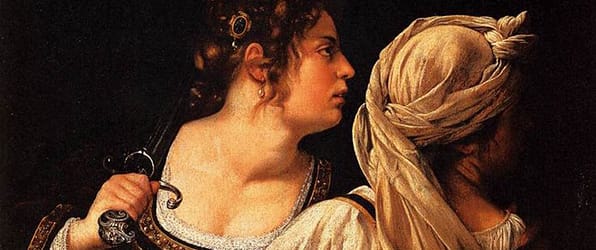
After being raped by her painting tutor when she was just a teenager, seventeenth-century trailblazer Artemisia Gentileschi developed into a bold and assertive woman, who filled her often-autobiographical artworks with images of empowered, rather than victimized women.
Important Art by Artemisia Gentileschi
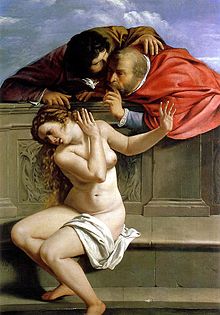
Susanna and the Elders
This accomplished painting is the first work known to be entirely painted by Artemisia Gentileschi, completed when she was 17 years old. The work shows a frequently depicted biblical scene: two voyeuristic elders spy on the virtuous Susanna while she is bathing, then attempt to blackmail her into having sexual relations with them with false accusations of adultery. While many artists have chosen this subject, Susanna is usually presented as unaware of the elders' presence, or even welcoming them in a flirtatious fashion. Gentileschi, on the other hand, shows Susanna's distress at being watched and accosted by the men, presenting the incident as a traumatic event. Although the work shows the clear influence of her father stylistically, the subject matter is more dramatic and expressive than his.
Susanna's response is at the center of the painting, demonstrating Gentileschi's unprecedented psychological realism, particularly in her presentation of women. Feminist art historian Mary Garrard argues that "Artemisia's Susanna presents us with an image rare in art, of a three-dimensional female character who is heroic". She goes on to explain that "the expressive core of Gentileschi's painting is the heroine's plight, not the villains' anticipated pleasure," and this offers an entirely different set of concerns to many of her male counterparts. Gentileschi painted this image prior to her rape by Tassi and the subject matter may reflect sexual harassment that she was receiving at his and other artists' hands once she began training at his studio.
Oil on canvas - Schönborn Collection, Pommersfelden
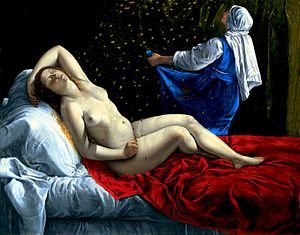
Danae
The Greek myth of Danae tells the story of a young woman confined to her bedchamber by her father, King Acrisius of Argos. It was a ploy to prevent her getting pregnant as an oracle had predicted that she would bear a son who would cause Argos’ death. The King of the Gods, Zeus, transformed himself into a shower of gold and succeeded in impregnating her in this form and it is this moment that Gentileschi depicts here. The son Danae bore was Perseus who later fulfilled the prophecy.
Danae was a traditional subject for paintings and had previously been depicted by artists including Titian and Tintoretto. Representations were either of Danae as pure and chaste or promiscuous and greedy, eagerly accepting the gold. In the work, Gentileschi references some of the these tropes, including the servant in the background catching the gold, but she also subverts them. Gentileschi's Danae is neither sexually aggressive nor innocently unaware, instead she is shown in the process of experiencing the consummation. There is some debate as to the meaning of this and it has been suggested by art historians Keith Christiansen and Judith W. Mann that "the painting depicts the sexually aroused Danae". They go on to argue that "Danae's fist, the coins pushed between the clenched fingers, also becomes a metaphor for sexual embrace" and that she is shown enjoying her sexual union with Zeus. Alternatively, professor Jeanne Morgan Zarucchi has argued that this image shows sexual violence and resistance as Zeus forces himself onto Danae. This is in line with the semi-autobiographical nature of Gentileschi's early works which often reference sexual assault.
This painting was originally attributed to Orazio Gentileschi but this was reconsidered in the late 1990s, predominantly due to the similarities in pose and composition to Artemisia's Cleopatra (1621) painted some ten years later. Artemisia's use of rich colors, subtle flesh tones, and texture are also evident in the work, particularly in the red sheet and the contrast between the metal coins and Danae's bare flesh.
Oil on copper - Saint Louis Art Museum
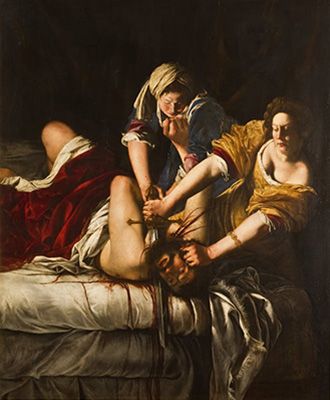
Judith Slaying Holofernes
In this painting, Gentileschi depicts another popular biblical scene (which she herself returned to more than once during her career): the slaying of Holofernes by Judith. Traditionally portrayals had focused on the beauty and courage of Judith rather than the process of the beheading itself. In 1598, however, Caravaggio painted the scene with an unprecedented degree of realism. Gentileschi took this realism (both psychological and physical) a step further, by considering the identities of the women and the significant physical demands of beheading someone. The painting contains an intense energy, from Holofernes' grasping fist and the struggle of the women to complete the task to the spurting blood from the neck wound. This dynamism is further highlighted by the use of bold colors and dramatic chiaroscuro.
In this painting, Gentileschi presents a portrait of women's power, while simultaneously asserting her own power as an artist with the capacity to choose her own subjects and make her own decisions about how to treat them. As The Guardian's senior art critic Jonathan Jones argues, "In most paintings, including Caravaggio's hallucinatory rendering, Judith has a servant who waits to collect the severed head. But Gentileschi makes the servant a strong young woman who actively participates in the killing. This does two things. It adds a savage realism that even Caravaggio never thought of - it would take two women to kill this brute. But it also gives the scene a revolutionary implication. 'What,' wonders Gentileschi, 'if women got together? Could we fight back against a world ruled by men?'" Notably, this is one of several paintings by Gentileschi that depict women taking revenge or punishing men. This can be seen as an expression of her frustration and anger after her rape and trial as a teenager and it has been suggested that Judith is a self-portrait of the artist.
Oil on canvas - The Uffizi Gallery, Florence
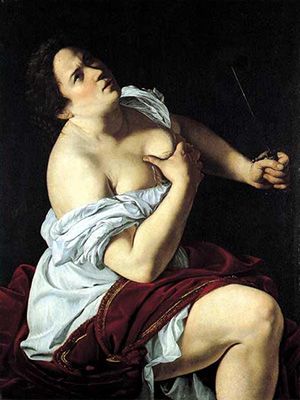
Lucretia
In this painting, Gentileschi presents Lucretia, a figure from classical mythology who was raped and, after confessing what had happened, killed herself. In doing so Lucretia became a popular symbol of female defiance against male tyranny. Here, Gentileschi depicts the moment in which Lucretia makes the decision to stab herself. The image is pared down in terms of detail - Lucretia is without jewelry or the trappings of wealth seen in other images and she wears only a disheveled slip, perhaps indicating the rape has only just occurred. This simplicity along with the close crop and dramatic lighting, which highlights her face and breast, places the focus firmly on Lucretia, presenting her as a solitary figure and emphasizing her personal agency in her decision to commit suicide after being mistreated by men. Whereas other (male) artists had often depicted Lucretia's rape or the pathos of her death, Gentileschi instead focuses on the psychological consequences of the rape. By grasping both her breast and the dagger, Gentileschi draws attention to the character's femininity and the nurturing potential of the woman, as well as indicating her bold intention. The act that is about to occur is anticipated in the blood red of the fabric which spills across her lap and out of the pictorial frame.
Gentileschi's portrayal of Lucretia is an important example of what the art historian Mary Garrard has termed the artist's creation and promotion of the 'female hero' in her art - "a three-dimensional female character who is heroic in the classical sense" - something which is otherwise missing from 17th century painting. Garrard argues that Gentileschi repeatedly presents women in this way by focusing on the psychology of her subjects and moving the viewer to feelings of pity and awe.
Oil on canvas - Gerolamo Etro, Milan
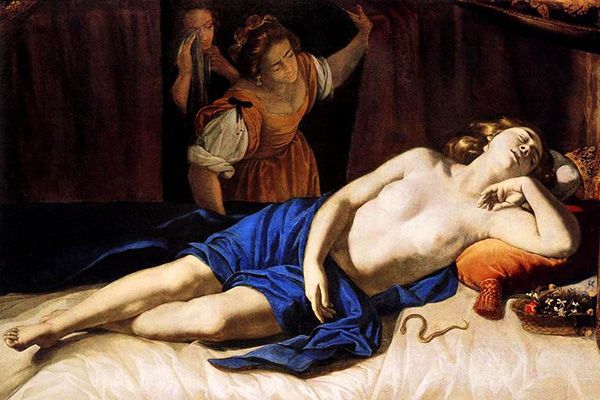
Cleopatra
In this work, Artemisia Gentileschi presents yet another woman who had been exoticized as a sexual temptress by her male counterparts. Gentileschi shows the moment when Cleopatra's suicide is discovered by two of her female attendants. Cleopatra's stiff position indicates the onset of rigor mortis, pointing to Gentileschi's quest for realism, and many of the details follow Plutarch's description of the moment of Cleopatra's death. The pose also recalls the Roman sculpture Sleeping Ariadne (believed to be Cleopatra in the 17th century), indicating Gentileschi's knowledge of classical art.
In this painting, Gentileschi presents a complicated vision of female power and powerlessness. She shows Cleopatra's self-inflicted and solitary death brought about by her mistreatment by men. In some ways this can be seen as an example of female agency in that she made the personal choice to respond in this manner. Conversely, by not focusing on the decision itself, as in Lucretia, but on the aftermath, the painting acts as a strong symbol of the lack of recourse that women had available to them and the impact that this had on those around them, in this instance the female attendants at the back of the painting.
Gentileschi, however, also uses some tropes typical of male painters of the period to present Cleopatra's semi-nude body to the viewer. In this as in other similar works, Gentileschi portrays nude women in sleep or in death, placing the viewer in the position of voyeur. In their book about Orazio and Artemisia Gentileschi, Keith Christiansen and Judith W. Mann argue that in such images Artemisia sometimes played to the demands of the art market in presenting some of her female heroes: "The representation of a slumbering female raises questions about reading Artemisia's imagery in terms of forceful heroines with whom Artemisia could identify. While she has minimized some of the patently sexual references used by other artists, she has presented a vulnerable female, unaware of the viewer's gaze, who becomes an inadvertent object of male desire, evidence of Artemisia's willingness to respond to the requests of male patrons".
Oil on canvas - Private Collection
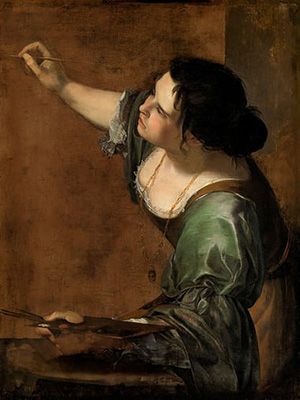
Self-Portrait as the Allegory of Painting
In this confident later work, Artemisia Gentileschi presents an allegory of painting using her own self-portrait as the subject. Painting was traditionally presented as a woman in allegorical scenes, giving Gentileschi a unique opportunity as a professional woman artist to present herself in the role. In doing so, she creates a realistic portrait of a painter at work, carefully rendering the tools of her trade such as the palette and brushes with quick and fluid brushstrokes. The brown background is often interpreted as the blank canvas onto which she is painting, demonstrating her ongoing and unfinished work as an artist.
Gentileschi follows the standard iconography for the allegory of painting. This is described in Cesare Ripa's Iconologia, the key iconographical handbook of the period, as "a beautiful woman, with full black hair, dishevelled, and twisted in various ways, with arched eyebrows that show imaginative thought, the mouth covered with a cloth tied behind her ears, with a chain of gold at her throat from which hangs a mask, and has written in front 'imitation'". The gag, intended to indicate that painting is silent, however, is notably absent from this depiction. Through this omission, Gentileschi suggests both a painting's ability to speak volumes and her own refusal to be silenced as a woman and as an artist. References in her personal correspondence note that Gentileschi painted a number of self-portraits, although few survive and it is likely that these were in demand from collectors who were attracted by her ability as an artist and her unusual status as successful female painter.
Oil on canvas - Royal Collection, London
Biography of Artemisia Gentileschi
Childhood
Artemisia Gentileschi was born on July 8, 1593, in Rome to Prudentia Montone (who died when Artemisia was 12), and Orazio Gentileschi, a well-known painter. The eldest of several children, Gentileschi quickly showed an aptitude for art and began to learn from her father. Orazio was a friend of Caravaggio, the provocative painter at the forefront of the art scene in Rome. Together, Orazio and Caravaggio were once charged for writing slanderous graffiti on the streets of Rome about another painter. During the trial, Orazio told an anecdote about Caravaggio visiting his house to borrow some angel wings, indicating that the great artist was intimate with the Gentileschi family and suggesting that the eldest daughter Artemisia would have met him. Regardless, when Artemisia was 13, Caravaggio was implicated in a murder and forced to flee from Rome to Naples. Despite this, Caravaggio's influence can be seen in the work of both Orazio and Artemisia.
Early Training and Work
In 1611, Orazio was hired to decorate the Palazzo Pallavicini-Rospigliosi in Rome, alongside another painter, Agostino Tassi. Hoping to help the 17-year-old Artemisia to refine her painting technique, Orazio hired Tassi to tutor her. This gave Tassi one-to-one access to Artemisia and during one of their tutoring sessions, he raped her. She later described the ordeal, "He then threw me on to the edge of the bed, pushing me with a hand on my breast, and he put a knee between my thighs to prevent me from closing them. Lifting my clothes, he placed a hand with a handkerchief on my mouth to keep me from screaming".
After the rape, Artemisia started a relationship with Tassi, believing that they were going to be married, but Tassi, later, refused to wed her. Orazio took the unusual decision to press charges against him for rape and the subsequent trial went on for seven months. This hinged on the fact that Artemisia had been a virgin before Tassi had raped her. The trial revealed various other scandalous details, including accusations that Tassi had murdered his wife. As part of the court proceedings, Artemisia had to undergo a gynaecological examination (to prove her claim that she had been a virgin), and she was tortured with thumbscrews in order to test the truthfulness of her testimony. For an artist, this form of torture could have been devastating, but Artemisia fortunately avoided permanent damage to her fingers. Her impassioned testimony, where she claims she might have killed Tassi after the rape, gives an indication about her character and her determination.

Tassi was eventually found guilty and was punished by being exiled from Rome. This sentence, however, was never carried out as Tassi received protection from the Pope due to his artistic skill. Notably, many of Artemisia Gentileschi's subsequent paintings feature scenes of women either being attacked by men, or in positions of power seeking revenge.
A month after the trial had finished, Orazio made arrangements for Artemisia to marry the artist Pierantonio Stiattesi. The pair moved to Stiattesi's home town of Florence. Here she received one of her first major commissions, for a fresco at the Casa Buonarotti, the home of Michelangelo, which was being turned into a monument and museum to the painter by his great nephew.
Mature Period
While living in Florence, Artemisia became the first woman to be accepted into the prestigious Accademia delle Arti del Disegno (the Academy of Arts and Drawing). This allowed her to purchase her artistic supplies without the permission of her husband and to sign her own contracts. She also gained the support of the Grand Duke of Tuscany, Cosimo II de'Medici, from whom she received various lucrative commissions.
In 1618, Artemisia and her husband had a daughter, Prudentia, who was named after Artemisia's deceased mother. Around this time, Artemisia started a passionate affair with a Florentine nobleman called Francesco Maria di Niccolò Maringhi. Their affair is documented by a series of letters from Artemisia to Maringhi, discovered by the academic Francesco Solinas in 2011. Unconventionally, Artemisia's husband knew about the affair and used his wife's love letters to correspond with Maringhi himself. It seems that Maringhi was partially responsible for keeping the couple financially solvent, something that was a frequent concern for them due to Stiattesi's mishandling of money.
Financial problems, alongside widespread rumors regarding Artemisia's affair triggered disagreement between the couple and in 1621, Artemisia returned to Rome without her husband. Here, she continued to be influenced by the innovations of Caravaggio and worked with several of his followers, including the painter Simon Vouet. She was not as successful in Rome as she had hoped and towards the end of the decade she spent some time in Venice, presumably searching for new commissions.
Late Period
Continuing her itinerant lifestyle without her husband (but with her daughter), Gentileschi moved to Naples in 1630, where she worked with a number of well-known artists such as Massimo Stanzione. In 1638, Artemisia was invited to the court of Charles I of England in London where her father had been the court painter since 1626. Orazio had made his name as the only Italian painter in London and one of the first artists to introduce the style of Caravaggio to England. Despite the fact that they had not seen each other for more than 17 years, there is little record of Orazio and Artemisia's reunion. Whilst in London Artemisia painted some of her most famous works including her Self-Portrait as the Allegory of Painting (1638). It has also been suggested that she worked alongside her father on an allegorical fresco for the Greenwich residence of Charles I's wife, Queen Henrietta Maria. Orazio died in 1639 at the age of 75 and so it is possible that Artemisia's assistance was necessary for the completion of this significant project, particularly as Orazio would have been an elderly man.
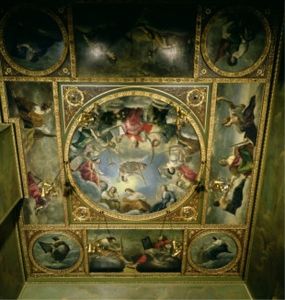
Artemisia appears to have remained in London for a couple of years after her father's death, although she had definitely left England by the time Civil War broke out in 1642. Little is known of her later movements, although correspondence with her patron Don Antonio Ruffo suggests that she returned to Naples. The last surviving letter between the two is dated 1650 and implies that she was still actively working at this point. Her date of death is uncertain; there is some evidence to suggest that she was still working in Naples in 1654, and it has been speculated that she may have died of the plague which devastated the city in 1656.
The Legacy of Artemisia Gentileschi
Artemisia Gentileschi's legacy has been controversial and complex. Although well-respected and well-known during her lifetime, after her death she was almost entirely omitted from art historical accounts of the period. This is partly because her style was often similar to that of her father and many of her works were mis-attributed to Orazio.
Artemisia's work was rediscovered in the early 1900s and was particularly championed by the Caravaggio scholar Roberto Longhi. Both academic and popular accounts of her life and painting, however, were colored by exaggerated and overly sexualized interpretations. This is partly due to a sensationalized novel about Artemisia published by Longhi's wife Anna Banti in 1947.
In the 1970s and 1980s, feminist art historians such as Mary Garrard and Linda Nochlin began to reassess this understanding of Artemisia Gentileschi and to change the artist's academic and popular reputation, focusing on her significant artistic achievements and her influence on the course of art history rather than on her biography. In the catalogue for the influential 1976 exhibition 'Women Artists: 1550-1950', the art historian Ann Sutherland Harris argued that Artemisia Gentileschi was "the first woman in the history of western art to make a significant and undeniably important contribution to the art of her time".
Influences and Connections

-
![Caravaggio]() Caravaggio
Caravaggio - Orazio Gentileschi
- Annibale Caracci
- Simon Vouet
- Massimo Stanzione
Useful Resources on Artemisia Gentileschi
- Artemisia GentileschiOur PickBy Mary D. Garrard
- Artemisia Gentileschi: The Language of PaintingBy Jesse Locker
- Orazio and Artemisia GentileschiOur PickBy Keith Christiansen and Judith W. Mann
- Artemisia Gentileschi and Feminism in Early Modern EuropeOur PickBy Mary D. Garrard
- I Know What I Am: The Life and Times of Artemisia GentileschiOur PickBy Gina Siciliano
- Artemisia Gentileschi (Lives of the Artists)Our PickBy Jonathan Jones
- Artemisia Gentileschi: Her Life, Her Genius, Her DueBy Francesca Elia
- The Artemisia Files: Artemisia Gentileschi for Feminists and Other Thinking PeopleOur PickBy Mieke Bal
- By Her Hand: Artemisia Gentileschi and Women Artists in Italy, 1500-1800By Eve Straussman-Pflanzer and Oliver Tostmann
- Artemisia Gentileschi in a Changing LightOur PickBy Sheila Barker
- Artemisia Gentileschi: The Image of the Female Hero in Italian Baroque ArtBy Mary D. Garrard
- Artemisia Gentileschi around 1622: The Shaping and Reshaping of an Artistic IdentityBy Mary D. Garrard
- Artemisia Gentileschi and the Authority of Art: Critical Reading and Catalogue RaisonnéOur PickBy Ward Bissell
